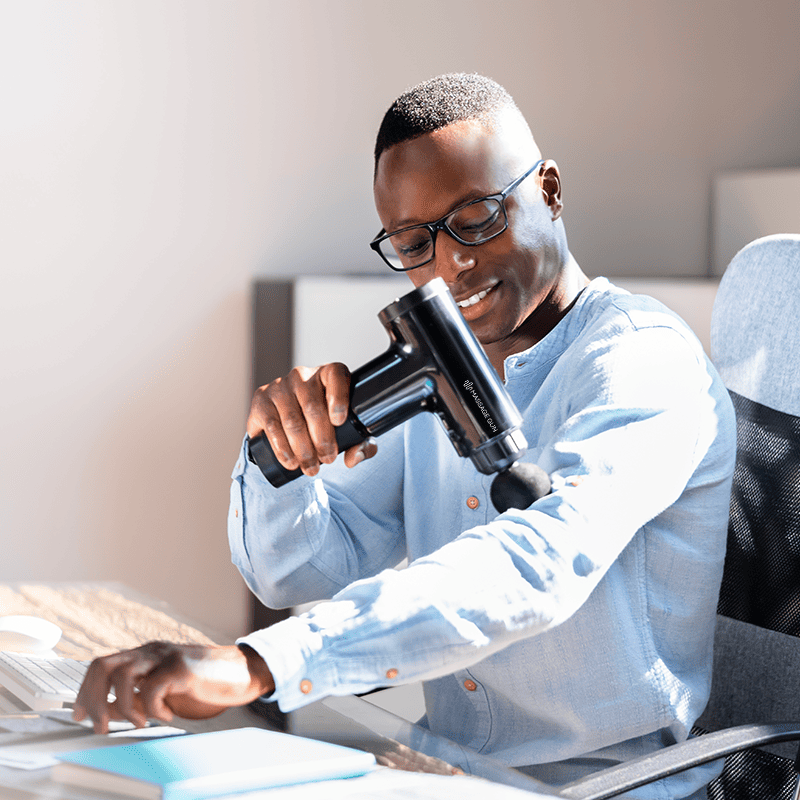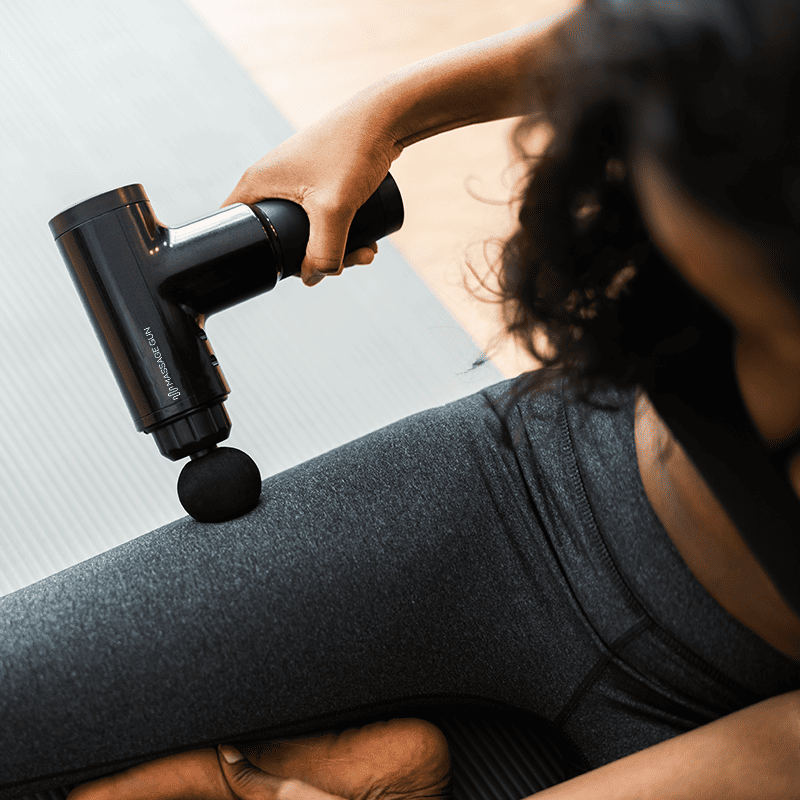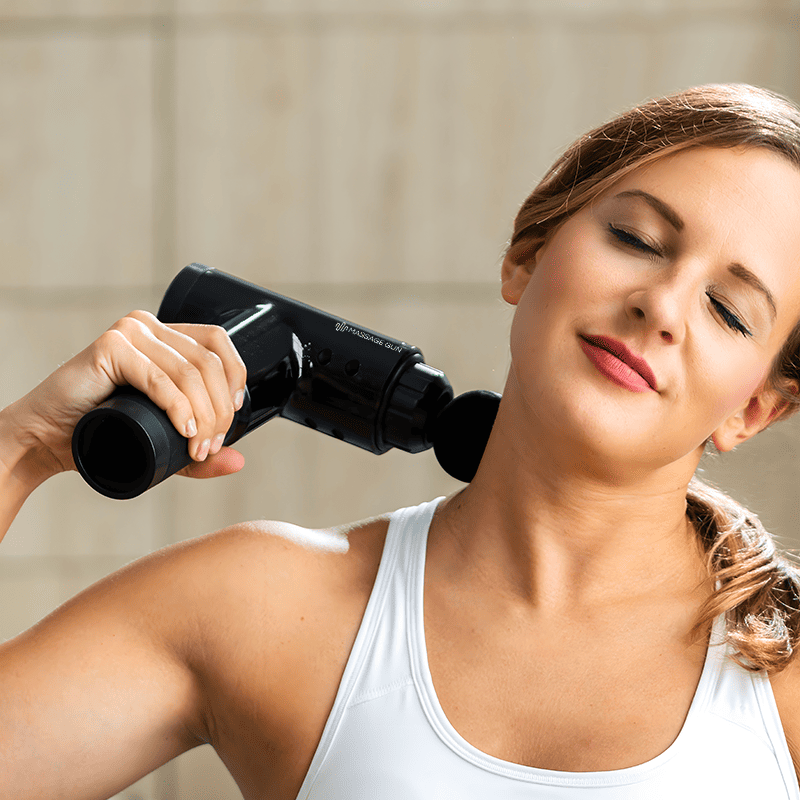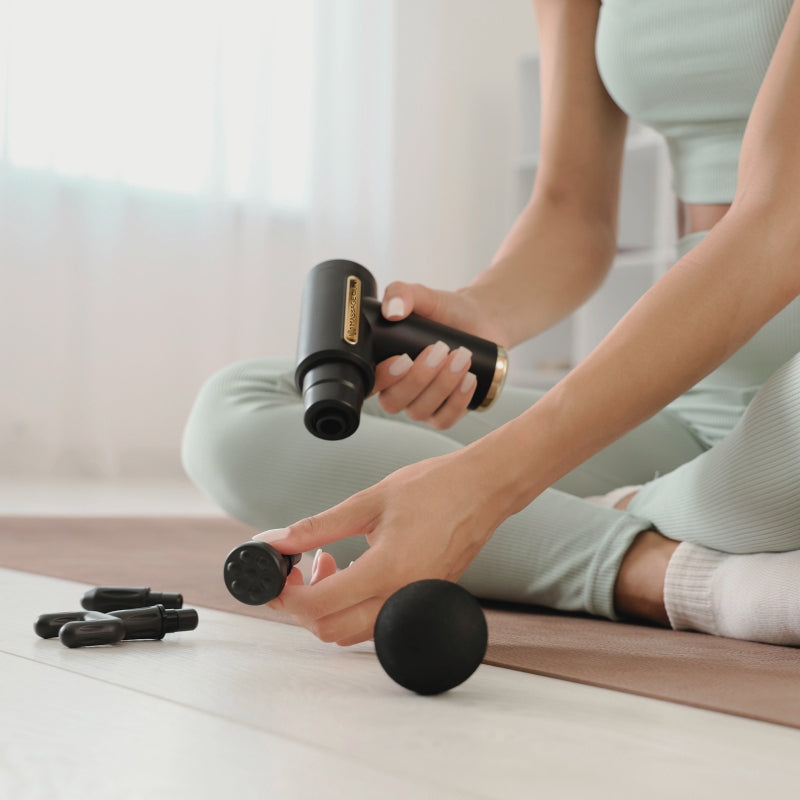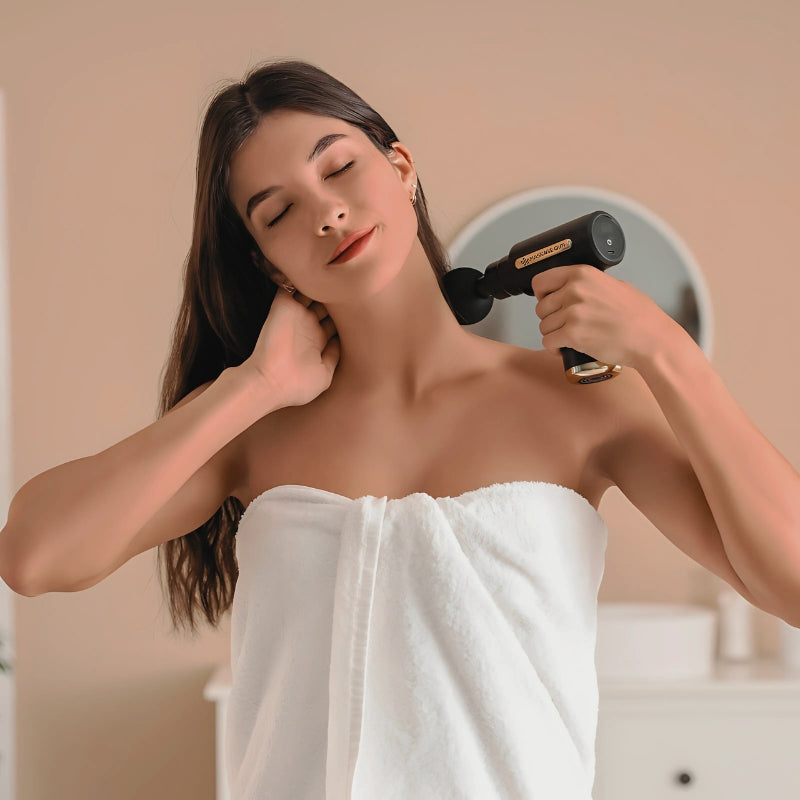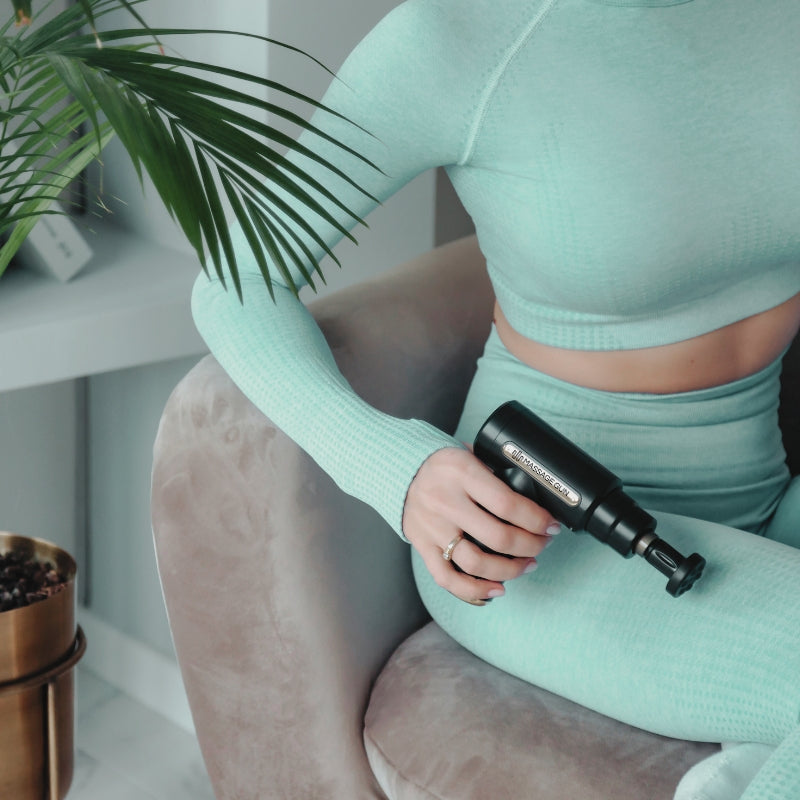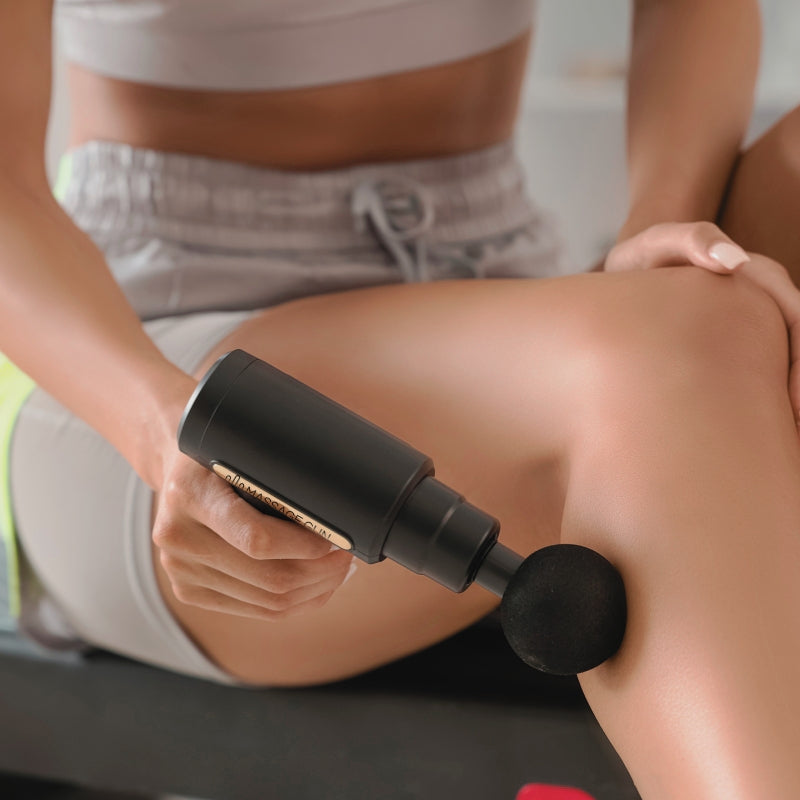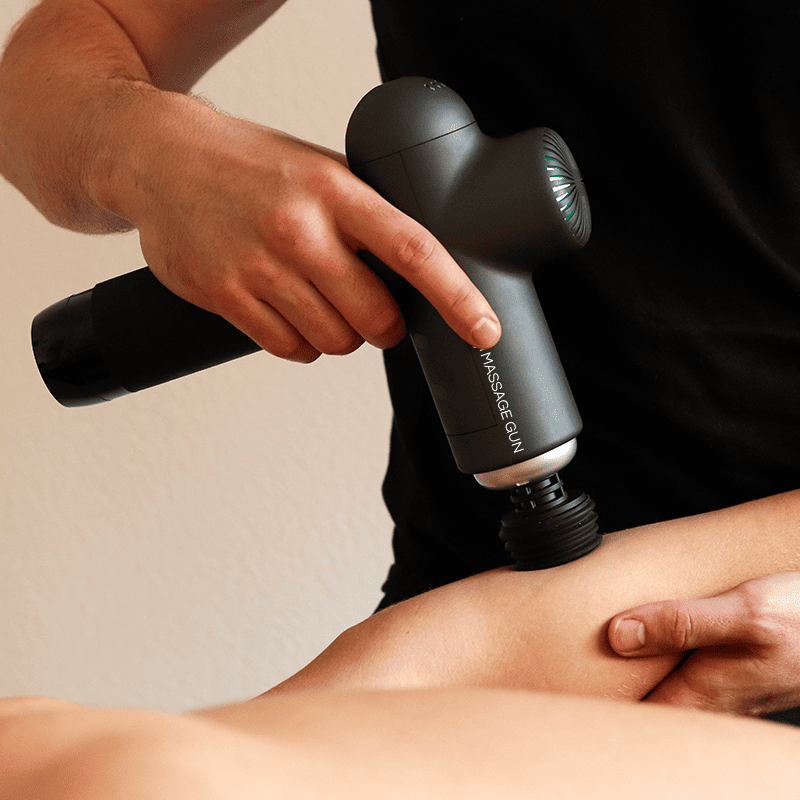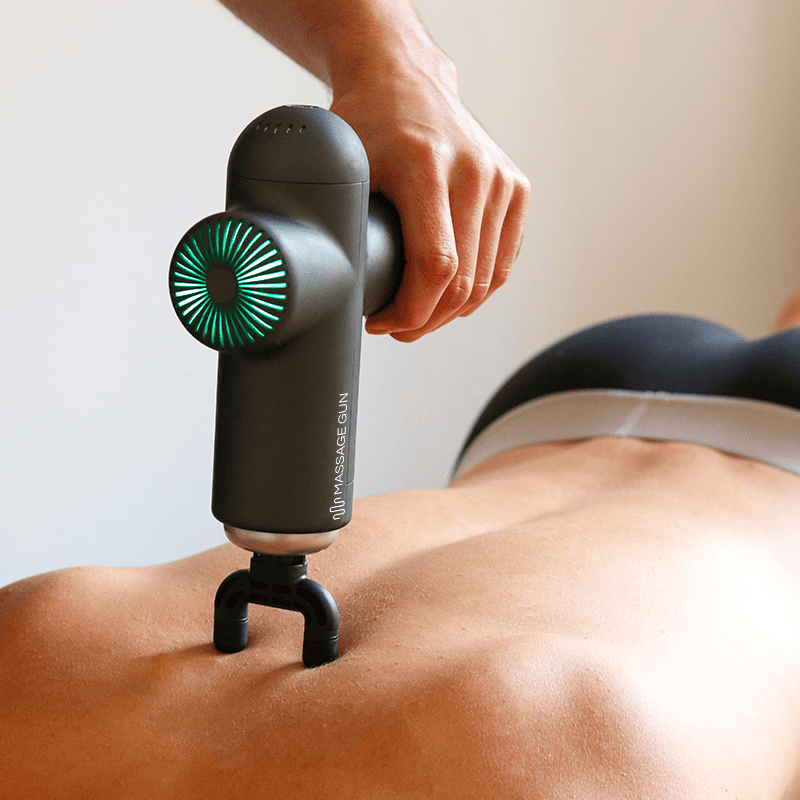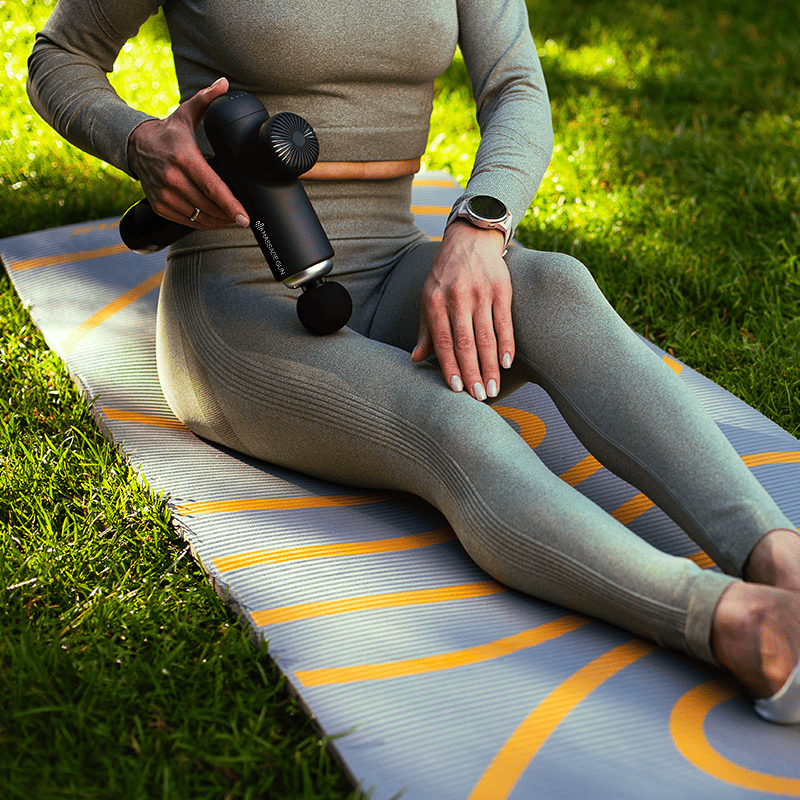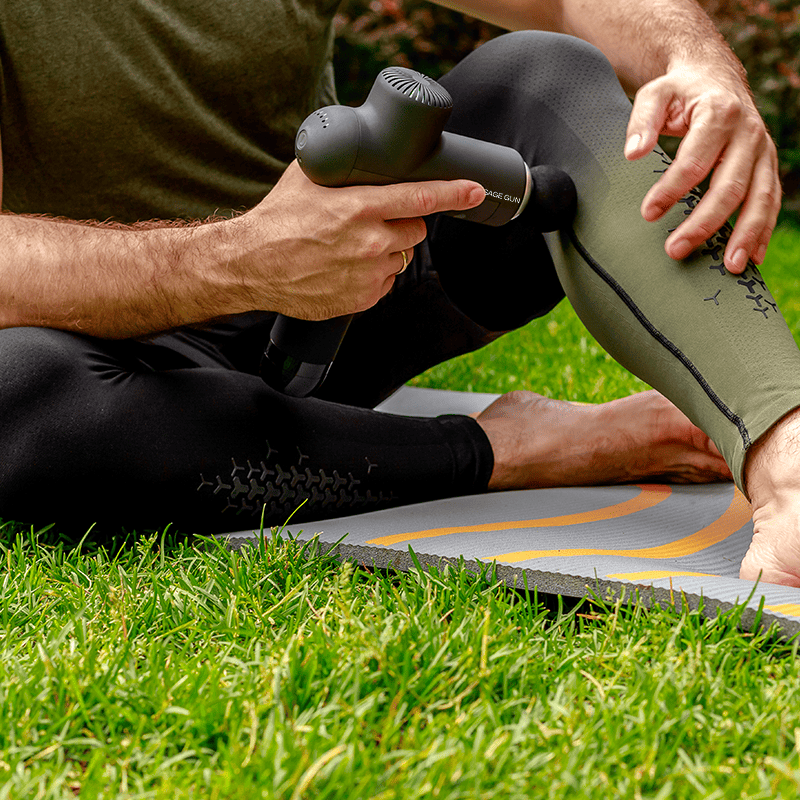Massage guns have surged in popularity as go-to devices for muscle recovery and soreness relief. These handheld devices, known for delivering percussion massage, target specific areas of the body to improve circulation, alleviate sore muscles, and reduce muscle stiffness.
They are highly effective in treating tight muscles and promoting recovery after strenuous physical activity. But are they worth the investment? In this article, we’ll break down the health benefits, potential drawbacks, and how to use massage guns to help with recovery.
How massage guns work?

Massage guns use percussion therapy to deliver rapid, concentrated pulses to a specific area, like the leg, lower back, or shoulder. These bursts of pressure penetrate deep into muscle tissue, helping to release fascia and scar tissue while improving mobility and blood circulation.
This percussive massage helps reduce lactic acid buildup, which typically causes post-workout muscle soreness and tightness. By increasing fluid movement and promoting the release of tension, massage guns offer an efficient way to treat muscle discomfort after physical activity.
Science behind percussive therapy vs. traditional massage

While both traditional massages and percussion massagers target muscle tension, the system used by massage guns focuses on high-frequency vibration therapy to deliver results more quickly.
Scientific evidence supports that vibration and percussion massage can decrease onset symptoms of soreness by promoting blood flow and aiding the body’s rehabilitation process.
According to a clinical review in the International Journal of Sports Medicine, vibration therapy is an effective treatment for muscle soreness, particularly for tight muscles and those recovering from eccentric exercise.
The benefits of massage guns for muscle soreness
Massage guns provide numerous health benefits, particularly in reducing onset muscle soreness, improving mobility, and promoting recovery within 48 hours after a workout. By targeting specific areas of muscle discomfort, they help with tight muscles, relieve pain, and reduce muscle damage.
Massage guns can help improve flexibility and decrease symptoms of soreness by enhancing the body's blood circulation and fluid flow. Additionally, using a massage gun can help break down fascia, reduce scar tissue, and promote muscle healing.
Boosting athletic performance through recovery
Athletes are increasingly turning to percussive therapy to promote recovery and prevent injuries. Regular use of a percussion massager can help not only with muscle soreness, but also with reducing muscle damage during intense physical activity.
In fact, studies show that massage guns can alleviate low back pain and leg pain more effectively than traditional methods. After using a massage gun, athletes often experience enhanced mobility and recovery, which can significantly improve performance in the next session or workout.
Are there any downsides to massage guns?

Though massage guns can help treat soreness, they aren't without risks. Incorrect use can lead to bruising, overstimulation, or increased discomfort. People with pre-existing injuries, such as bone fractures or nerve damage, should be cautious. Multiple sessions in the same area could lead to tension and even fluid retention if used excessively.
Furthermore, while massage guns are beneficial, they may not replace the experience of a traditional massage treatment for addressing deeper issues like lower back pain or persistent muscle tension.
Hidden costs of massage gun overuse
While massage gun therapy is effective, overusing these devices can overstimulate muscles, leading to scar tissue buildup and reduced circulation over time. Over-reliance on massage guns could hinder natural muscle recovery and decrease the body’s ability to self-heal.
This can be especially problematic for individuals dealing with tight muscles or nerve injuries. It's essential to consult an expert, like a physical therapist, and create a balanced treatment routine that integrates both massage gun therapy and traditional recovery methods.
Comparing massage guns with other recovery tools
Massage guns have distinct advantages compared to other muscle recovery tools like foam rollers or vibration plates. Percussion massagers provide deep tissue penetration, whereas foam rollers are better for targeting larger muscle groups.
Additionally, unlike foam rollers, massage guns can be used on tight muscles or in specific areas of the body without requiring awkward positions. Physical therapy sessions can complement massage gun use, especially when dealing with low back pain or post-exercise soreness.
The future of muscle recovery: what’s beyond massage guns?

Emerging recovery techniques, such as cryotherapy and electrical muscle stimulation, are now available to complement massage gun use. These techniques, including targeted vibration therapy, are used to enhance muscle recovery, promote lymphatic drainage, and treat more than one muscle group at a time.
Scientific studies suggest that integrating these new treatments with massage guns could offer athletes a more comprehensive solution for reducing soreness and preventing injuries.
How to properly use a massage gun?

To get the most benefit from your massage gun, it's crucial to use it correctly. Start by choosing the right attachment for the muscle group you’re targeting, whether it’s your leg, lower back, or shoulders. Glide the massager over the muscle area slowly, adjusting the speed setting as needed.
If you're treating post-workout soreness, spend no more than 1-2 minutes per specific area to avoid overstimulation. Experts recommend using massage guns before and after workouts to reduce muscle soreness and help with recovery.
Creating a personalized recovery routine
Everyone’s body responds differently to massage gun therapy, so it's essential to tailor your recovery routine. For some, using a percussion massager before workouts can enhance blood circulation and reduce muscle stiffness.
For others, using it post-workout may be more beneficial for reducing soreness and promoting recovery. To maximize the benefits, combine massage gun use with stretching, hydration, and rest to decrease symptoms of soreness.
When to avoid using a massage gun?
While massage guns are useful for recovery, there are situations where they should be avoided. If you're dealing with acute injuries like sprains or nerve damage, using a massage gun can aggravate the condition. It's also important not to use the massager on broken skin or bruised areas.
Experts advise against using massage guns if you have conditions like blood clots or bone injuries, as this can lead to serious complications. Always consult with a health professional if you’re unsure.
Massage gun safety myths debunked
It’s commonly thought that more intense vibration therapy yields better results, but this isn't necessarily true. Overusing a massage gun at high speeds can actually increase muscle damage rather than promote healing.
It’s also a myth that massage guns can treat all types of soreness. For deeper issues like low back pain or nerve compression, it’s better to consult a healthcare professional for effective treatment.
Should you buy a massage gun?

If you frequently experience muscle discomfort after workouts, a massage gun could be an excellent investment. They help relieve pain and promote faster recovery after exercise.
However, it’s essential to find a model that suits your needs, including adjustable speed settings and the right attachments. Look for reviews from experts to ensure the percussion massager you choose is both high-quality and effective.
Eco-friendly and portable massage guns

For eco-conscious buyers, some massage guns are designed with sustainable materials and energy-efficient systems. These portable options come with compact designs and are perfect for people who want to take their recovery tool on the go.
Look for models that have multiple speed settings and attachments to make them more versatile. Incorporating this kind of tool into your routine can significantly improve your overall mobility and recovery.
Conclusion: are massage guns worth it for soreness relief?

Overall, massage guns can help relieve soreness, reduce muscle stiffness, and promote recovery. They’re an excellent tool for athletes and casual exercisers alike. However, it's essential to use them responsibly and integrate them into a broader recovery plan that includes stretching, hydration, and rest.
By using a massage gun within 48 hours after intense physical activity, you can help relax muscles and experience better post-workout recovery.
Frequently asked questions

1. Do massage guns actually help with soreness?
Yes, massage guns are highly effective in reducing muscle soreness. They use percussive massage to increase blood flow, promote lymphatic drainage, and release muscle tension in targeted areas of the body. This helps alleviate stress on the muscles, reduce soreness, and improve range of motion.
According to a study in the Journal of Sports Medicine, massage guns can also help prevent delayed onset muscle soreness (DOMS) after a workout. They may help relieve muscle pain and promote faster recovery post workout, especially when used before a workout to prepare muscles for physical activity.
2. How do massage guns help with recovery?
Massage guns help with recovery by delivering percussive therapy that targets sore muscles, promoting blood flow and helping the whole body recover. This movement aids in breaking down scar tissue, improving flexibility, and reducing muscle tension during physical activity.
With a massage gun, you can target specific areas that might feel tight after a workout, such as the head or legs. Studies have shown that regular use of massage guns can provide long-lasting pain relief by increasing circulation and helping muscles recover faster.
3. Can massage guns reduce muscle soreness after exercise?
Yes, massage guns can effectively reduce muscle soreness after exercise by improving range of motion and increasing blood flow to the sore areas. Post exercise, muscles tend to build up lactic acid, which can limit movement and increase stress on the body.
Using a massage gun after exercise helps reduce soreness by promoting lymphatic drainage and breaking down the buildup of lactic acid, which may help muscles recover more quickly and prevent future injury.
4. How long should you use a massage gun to relieve soreness?
To relieve soreness, you may want to use a massage gun for 1-2 minutes on each muscle group. Be careful not to overdo it, as repetitive use for too long in one area can lead to discomfort or even injury. Start with a low speed setting, especially if you're new to massage guns, and gradually increase intensity.
Before using a massage gun, always make sure you're properly hydrated and have warmed up your muscles to get the best effect. This routine may help improve your range of motion and decrease soreness.
5. Are there any side effects of using a massage gun for soreness?
While massage guns are generally safe, there are a few side effects to consider. Overuse or incorrect application can lead to injury, such as bruising or overstimulation of muscles. People with pre-existing conditions, such as limited mobility or head trauma, should be cautious and may need to avoid certain areas.
It's also important not to use a massage gun on broken skin, inflamed muscles, or joints, as it could worsen the condition. Make sure you consult with a healthcare professional if you’re uncertain about using the device.
6. Can massage guns help with lower back pain?
Yes, massage guns can provide relief for lower back pain by targeting muscle pain and improving circulation. However, caution is required, as the lower back is a sensitive area. Before using a massage gun on your lower back, make sure to avoid overuse and keep sessions short.
Regular use can help reduce soreness and promote blood flow, which can alleviate discomfort and tension. For chronic lower back pain, it’s always best to consult with a physical therapist to ensure you're using the device safely.
7. Are massage guns better than foam rollers for soreness relief?
Massage guns and foam rolling are both effective for soreness relief, but they work differently. Massage guns provide more targeted pain relief by delivering percussive therapy to specific areas, making them ideal for treating sore muscles.
Foam rolling, on the other hand, is better for general muscle recovery and lymphatic drainage across larger muscle groups. The best approach is to combine both tools in your routine to get the benefits of increased blood flow and improved range of motion.
8. When should you avoid using a massage gun?
You should avoid using a massage gun if you have an acute injury or certain medical conditions, such as blood clots or fractures. If you're recovering from surgery or experience chronic pain in a specific part of the body, consult a healthcare professional before using a massage gun.
It's also important not to use the device on sensitive areas, such as the head or neck, where repetitive pressure could cause more harm than good.
9. How does a massage gun work on tight muscles?
A massage gun works on tight muscles by applying percussive therapy, which promotes blood flow and loosens muscle fibers. This movement helps break down scar tissue, reduce muscle stiffness, and improve range of motion.
With a massage gun, you can effectively target areas of muscle pain, such as the lower back, legs, or shoulders, and help the whole body recover faster after workouts. Regular use can help relax tight muscles and prevent post workout soreness.
10. What is the best way to use a massage gun for soreness?
The best way to use a massage gun for soreness is to focus on sore muscle groups for 1-2 minutes, applying steady, moderate pressure. Adjust the speed settings to suit your comfort level, and make sure you avoid applying too much pressure, as this may cause injury.
You can use the massage gun before a workout to warm up or post workout to help relax muscles and reduce soreness. To maximize benefits, combine massage gun use with proper hydration and stretching exercises, ensuring you're prepared for your next day of physical activity.




